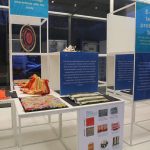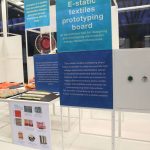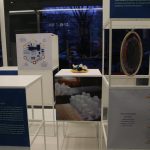designtransfer presents in the context of Vorspiel transmediale (15.01–28.03) online projects by students and alumni of UdK and in the outside showcase Einsteinufer 43 the installation “Engaging with e-static textiles” by Ramyah Gowrishankar.
Static electricity is usually considered an annoying phenomenon often associated with door-knob shocks, hair risings or clingy clothes. But it is also a form of everyday electrical energy that is closely related to how our bodies interact with textiles, and when handled safely, presents an exciting opportunity to envision new forms and interactions for e-textiles.
This was the starting point for the research project- “Engaging with e-static textiles” by Ramyah Gowrishankar.
Through the process of making, discovering and experimenting with the electrostatic generator circuit, the research explores the challenges and opportunities of using static electricity as a resource in design and development of e-textiles.
This installation for the Vorspiel transmediale 2021 at designtransfer gives a glimpse into the four year long research project. It shares examples of e-textile materials and interactions that make use of the electrostatic charges as a source of micro-energy or as a sensor input.
One of the key results presented here is the “e-static textiles prototyping board” developed during the project.The prototyping board is an educational tool that enables easy integration of high voltage inputs from electrostatic setups and can be sewn directly on textiles for designing and prototyping electrostatic energy-related interactions.
22 January – 28 February 2021, 24/7
Outside Showcase, Einsteinufer 43
To learn more about working with static electricity and e-textiles, please visit www.estatictextiles.cc
The doctoral dissertation “Engaging with e-static textiles” by Ramyah Gowrishankar is available online at https://doi.org/10.25624/kuenste-1357
“Engaging with e-static textiles” is a doctoral research project that was part of ArcInTex ETN, a Marie Sklodowska-Curie funded EU project which consisted of a consortium of 6 universities and 5 companies from around Europe. At the UdK, the Arcintex ETN project was jointly undertaken by the Department of Design and the Department of Architecture. More information about ArcintexETN is available at www.arcintexetn.eu

























